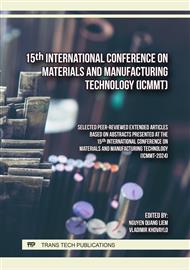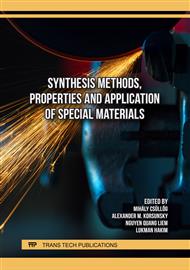p.71
p.81
p.87
p.97
p.109
p.119
p.131
p.137
p.143
Synthesis of Samarium Doped Tin Oxide Using Wet Chemical Precipitation Approach
Abstract:
The nanosized samarium doped tin oxide in varying concentration (0%, 0.5%, 1%, 3%, 5%) was successfully synthesized using the wet chemical precipitation approach. X-ray Diffraction (XRD) analysis was done to monitor the effect of the dopant concentration to the host lattice as broadening and narrowing of the formed peaks are seen. Average crystallite sizes of the produced sample are ranging from 9-28 nm, confirming it to be nanoscale. Identified peaks with Miller indices of ((110), (101), (200), (111), (211), (220), and (002) signifies a tetragonal rutile structure of the synthesized samples. Scanning Electron Microscopy (SEM) shows the difference in morphology for the powdered samples as per different samarium loading as well as the shape, which is granular. Energy Dispersive X-ray spectroscopy (EDX) affirms the successful integration of the samarium dopant to the lattice structure of the SnO2.
Info:
Periodical:
Pages:
137-141
Citation:
Online since:
September 2024
Keywords:
Price:
Сopyright:
© 2024 Trans Tech Publications Ltd. All Rights Reserved
Share:
Citation:



